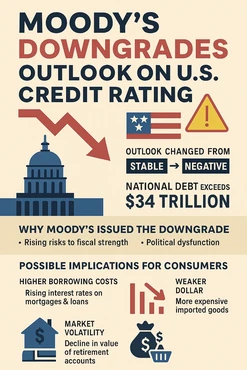Its not good news for consumers hoping to take out a loan
-
Borrowing may become more expensive, particularly for large loans like mortgages and auto financing.
-
Investment portfolios could take a hit as markets react to fiscal uncertainty.
-
Everyday prices may rise if the U.S. dollar weakens against other currencies.

In a move that sent tremors through global financial markets, Moodys Investors Service has downgraded its outlook on U.S. government debt from stable to negative, signaling concerns about Americas long-term fiscal health.
While the credit rating agency did not strip the U.S. of its AAA status, the warning is clear: unless the nation reins in its mounting debt and political gridlock, its reputation as the worlds most reliable borrower could be at risk.
On Wall Street, most Treasury bond yields are rising while the dollar is lower. For policymakers in Washington, this serves as yet another flashing red light. For everyday Americans, the implications could be both subtle and far-reaching, affecting everything from mortgage rates to retirement savings.
Why Moodys issued the downgrade
Moodys cited rising risks to the nations fiscal strength and political dysfunction as primary reasons for the change. The recent debt ceiling standoffs, ballooning federal deficits, and the rising cost of servicing the national debt have raised red flags among credit watchers.
The U.S. continues to benefit from extraordinary economic strengths, Moodys noted in its announcement, but political brinkmanship is undermining the reliability of its fiscal framework.
In other words, the U.S. still has one of the most powerful economies on Earth, but its politics are creating financial instability.
Moodys recent downgrade of US credit means all major rating agencies have now stripped the country of its top-tier credit rating, Kevin Rusher, founder of financial firm RAAC, said in an email to ConsumerAffairs. At this point, its no longer a warning, but a clear sign that confidence in government debt is falling as deficits keep growing and borrowing gets more expensive.
What this means for you
While a downgrade in outlook doesnt mean an immediate economic crisis, it can ripple through the financial system in ways that ultimately reach your household budget. Heres how:
-
Higher borrowing costs: If investors begin demanding higher interest rates to offset the perceived risk of U.S. debt, those costs could trickle down to consumer lendingraising rates on mortgages, car loans, and credit cards.
-
Market volatility: Retirement accounts and stock portfolios may feel the heat. A perceived weakening of U.S. creditworthiness can spook markets, resulting in lower asset values in 401(k)s and IRAs.
-
Weaker dollar: If confidence in the U.S. economy wanes, the dollar could decline in value, making imported goodsfrom electronics to foodmore expensive.
This isnt the first time a credit rating agency has raised a red flag. In 2011, Standard & Poors famously downgraded the U.S. credit rating in the wake of a similar debt ceiling crisis. Whats different now is the sheer scale of the national debt, which recently surpassed $34 trillion, and the speed at which interest payments are eating into the federal budget.
Analysts warn that if political divisions continue to stall fiscal reform, future downgrades could followthis time possibly lowering the countrys actual credit rating, not just its outlook.
For now, consumers dont need to panic, but it might be time to brace. Interest rates are already high, and this downgrade could add more fuel to the fire. At the very least, its a wake-up call to both policymakers and consumers alike: fiscal responsibility isnt just a government concern. It affects every wallet.
, , , ,
Posted: 2025-05-19 15:20:27















